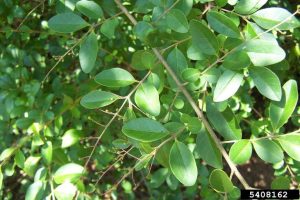
Chinese Privet (Ligustrum sinense) can be treated in November. For detailed information about Chinese privet, take a look at the Blue Ridge PRISM’s fact sheet.
After deciduous plants have dropped their leaves, you can use a foliar spray on the privet’s evergreen leaves. It’s best to cut larger privets down to a manageable size first and then apply recommended foliar herbicide. You’ll find a helpful list of recommended herbicides at the Forestry Department’s chart titled Non-Native Invasive Plant Species Control Treatments — Timing, Methods and Herbicide Rates. Check the section titled “General Recommendations for All Shrubs.” Other chemical options are the cut-stump method and basal bark treatment.
The Blue Ridge Partnership for Regional Invasive Species Management (PRISM) makes the following recommendations for treatment of Chinese privet in autumn:
“Cut Stump: This is an effective way to control privet. Cut or
saw stems with loppers, a handsaw or a chainsaw, near ground level; immediately apply a concentrated, recommended herbicide to the cut stump. Monitor treated stumps for resprouts; cut stump any new growth, or use a foliar spray on the new leaves.
Foliar Spray: Chinese privet may be effectively controlled
with foliar sprays if you pay careful attention to application timing and herbicide concentration. The recommended herbicide is of a concentration higher than is needed to control most invasive plants. Because nearby desirable plants may be injured by spray drift when large shrubs are treated, cut or saw privets taller than 4 feet to a manageable size. Then spray the regrowth. This method also reduces the amount of herbicide needed. You will avoid damaging nearby plants if you spray privet, which is evergreen, in late fall or early winter when deciduous plants have dropped their leaves. Apply the herbicide on a mild day from November through January when it is above freezing.
Basal Bark: Extensive colonies of tall privets can be con-
trolled with basal bark applications if stems are smaller than 6
inches in diameter. This is less labor intensive than cut stumping. Some pruning and cutting back of lower branches may be necessary beforehand, however, to allow access. Paint or spray the entire circumference of the lower 12 inches of each stem with a concentrated, recommended herbicide mixed with vegetable or mineral oil along with a penetrant. Monitor for resprouts and treat as needed. Basal bark treatments can take a few months to kill privet, but are very effective.”